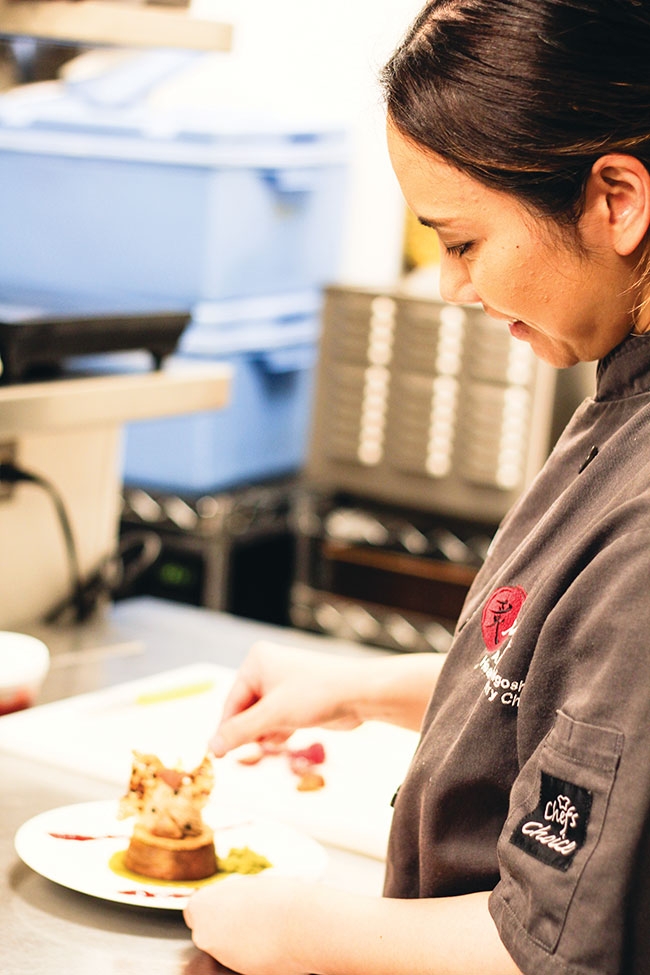
Where east ‘eats’ west
February 11, 2019
By
Bakers Journal
Chef Uchigoshi combines Japanese flavours with French techniques
 French presentation and Japanese flavours are hit at Miku Toronto.
French presentation and Japanese flavours are hit at Miku Toronto. Chef Aiko Uchigoshi has over 14 years of experience in pastry. Her expertise in both Japanese and French pastry made her a natural choice for Toronto’s Miku restaurant.
Chef Uchigoshi shared a few questions with Bakers Journal about the future of pastry in Canada, and she discussed some of the differences between Japanese and European pastry.
Bakers Journal / Tell Bakers Journal a little bit about yourself; what brought you where you are in your career, today?
Chef Uchigoshi / When I was 18, I went to culinary school for 2 years in Japan where I learnt all about Japanese, Chinese, and French cuisine. It started with savoury cuisine, but then I ended up exploring pastry and desserts. Following that, I worked at a hotel in Tokyo in their pastry department for 7 years. During this time I entered some competitions specifically for young pastry chefs, under the age of 23 – they were sugar ornament making competitions. I competed three times and earned 3rd place twice, and 2nd place.
I then worked at French restaurant in Tokyo for two years. Shortly after moving to Canada, I began working part-time at Miku Vancouver within their pastry team. After a while, I was promoted to head pastry chef at Minami, Miku’s sister restaurant. When the Aburi Restaurants Canada expanded to Canada’s east coast, I moved to Toronto to lead the pastry team of Miku Toronto!
BJ / When did your interest in pastry start?
CU / When I was young, I was already interested in cooking, but not pastry however, and that’s why I went to culinary school! I learned so much there. I wanted to learn as much as possible, so I told my instructor that I wanted to learn everything. My teachers recommended that I start working in pastry because normally the new chefs/cooks in a restaurant start in either pastry or appetizers, as it is the best way to learn.
When working with pasty, it is hard to perfect everything. Even now, I’m still learning! There are so many different techniques and styles, and they are constantly changing and evolving.
BJ / What keeps you inspired? You have been working in pastry for 14 years – do you ever get bored designing and making cake?
CU / Because [the pastry industry] keeps changing every year, there are always new innovations in dessert making, from new ingredients to machines. It keeps it exciting for me because I can experiment and use them in different ways, there are so many possibilities. For example, even with classic cakes, using new ingredients or machines you can make a completely different dessert. You can deconstruct a cake or dessert and it becomes something completely new!
BJ / What trends in formal cakes have you noticed emerging recently?
CU / Recently, a trend in cakes that I’ve noticed is mirror glaze cakes, specifically galaxy glaze. I think these cakes also represent an interest in more “Instagrammable” desserts as well as a general interest in space and the universe.
There also is a big trend towards natural ingredients, gluten free, dairy free.
I think people care about what goes into their food, and it’s something pastry chefs take into consideration when creating and decorating cakes.
BJ / Describe a cake design or recipe that took your breath away: What was it about that cake that you found exciting?
CU / I really like Cedric Grolet’s desserts. He’s a French pastry chef who was awarded the title of World’s Best Pastry Chef in the “Les Grandes Tables du Monde 2017” competition. I am always blown away by his pastries that look like realistic fruit. It’s made with a fruit compote filling surrounded by mousse and covered in a layer of cocoa butter.
BJ / What kind of cake would you consider ideal for mid-week, after- work consumption?
CU / My ideal mid-week, after-work dessert is actually chocolate truffles. It’s easy to eat and snack on, and the chocolate is good for you!
BJ / Aside from Miku’s delicious-looking matcha chocolate hazelnut layer cake, what cake is your personal favourite?
CU / My personal favourite are opera style or fruit cakes that have an alcohol component because it gives it more flavour.
BJ / How would you describe the differences between Japanese and French pastry?
CU / In the past, we didn’t really have great fruit to use in traditional Japanese pastry. That’s why our traditional sweets use mostly rice, beans, sesame, etc.
Japanese pastry is also less sweet and rich than French pastry and focuses on highlighting natural flavours. It’s usually one main ingredient with a minimum amount of sugar.
Traditional Japanese pastries may have many different looks to the dessert, but they are always made up of the same ingredients. For example, to create a seasonal iteration of a dessert, the dessert is shaped into the season, rather than adding a bunch of different seasonal ingredients.
I think nowadays, many Japanese pastry chefs put seasonal fruits and ingredients in their desserts, like mochi, (a marshmallow-like treat) but before these ingredients weren’t as accessible.
BJ / Where do you see the future of cake and pastry going in the next few years?
CU / I think it will be a very tight-knit industry. As for consumer trends, people will lean towards more natural ingredients, like vegetables, fruits, sugars/dyes made from fruits and vegetables.
I think cakes and pastries will be made to be more suitable towards healthier lifestyles. Small bite-sized desserts as opposed to large desserts, as well as gluten-free and dairy-free cake and pastry options will be more popular. /BJ
Print this page
Leave a Reply